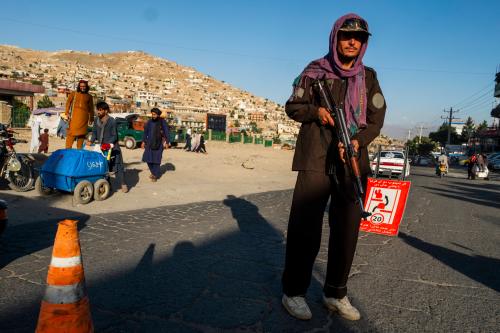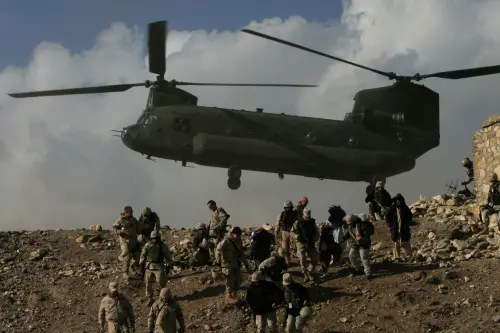Three years on, the Taliban regime remains firmly in power. Its supreme leader, Haibatullah Akhundzada, has strengthened and centralized his rule by creating parallel institutions while formulating policies from his tightly-knit Kandahar office. The regime has become more exclusionary, privileging southern Pashtun Talibs. Despite massive economic challenges, including more than 90% of Afghans struggling with poverty and increasing food insecurity, the regime is not at immediate risk of an economic implosion.
Afghanistan’s neighbors, as well as China and Russia, are intensifying their engagement with the Taliban regime. But Pakistan remains frustrated with the Taliban’s meager actions against the terrorist group Tehrik-e-Taliban Pakistan (TTP), which has bases in eastern Afghanistan. Despite the Taliban’s grave violations of human rights and women’s rights, U.S. interests in Afghanistan—including counterterrorism—are for now best served by maintaining a low-level equilibrium in engagement with the regime.
The Taliban’s power and its structures
The Taliban leadership includes dogmatic ideologues such as Haibatullah, as well as relative pragmatists who are more restrained in their desire to implement extreme versions of Sharia and interested in engagement with the West. Yet the pragmatists have failed to moderate the amir’s policies and have pulled back from challenging him.
Haibatullah is supported by a praetorian guard of powerful military commanders from Helmand and Kandahar, such as Abdul Qayyum Zakir. To counter rival leaders, such as Sirajuddin Haqqani and Mohammad Yaqub, Haibatullah has appointed his loyalists as deputy bosses across the regime’s ministries and agencies.
The Taliban regime refuses to integrate into its structures Afghan warlords, politicians, and most other individuals associated with the defeated Islamic Republic of Afghanistan. It has removed from office or demoted several non-Pashtun Taliban commanders. To monitor local actors, placate demands for inclusivity in policy decisions, and preserve its adroitness in resolving local disputes, the regime has established local religious ulama councils.
Human rights, such as freedom of expression, have been drastically weakened, with opposition actors and protesters arrested. In its gender apartheid—from the ban on girls’ education beyond primary school to restrictions on women’s travel and work—Haibatullah’s dogma stands out, even among various authoritarian Central Asian and Middle Eastern countries. But Haibatullah is impervious to criticism from Afghan and other Islamic religious scholars, other Taliban leaders, and other countries.
Yet underneath, the implementation of his edicts, such as restrictions on women in public spaces, girls’ education, and public executions, has been slow-walked, as local communities and Taliban officials dislike many of Haibatullah’s policies.
The regime’s economic viability
The shocks of Western sanctions, a profound liquidity crisis, and the collapse of Afghanistan’s economic system linked to the Western war machine produced a staggering contraction of Afghan GDP between 2021 and 2023 by 20%-30%. The economy has stabilized but is stagnating. At least 23 million Afghans, over half of the population, need humanitarian support, even as international aid has declined precipitously because of competing global needs, Western distaste for the Taliban’s repression, and Russia’s and China’s lack of interest in providing humanitarian assistance.
The Taliban’s effectiveness in reducing the immense corruption that characterized the republic boosted tax and revenue income. In 2023, Afghanistan benefited from brisk regional trade, including coal exports to Pakistan and exports of minerals across the region, amounting to $1.9 billion in Afghan exports. But in 2024, exports shrank substantially.
Implemented with stunning determination, Haibatullah’s ban on opium poppy brought cultivation down by over 95%. But it further immiserated Afghans. Wiping out 450,000 jobs at the farm level alone, the ban cost the Afghan economy at least $1.3 billion.
Haibatullah’s praetorian guard powerbrokers have benefited from the ban as the value of their heroin stockpiles skyrocketed. But if they cannot sell these stockpiles or eventually deplete them without the ban being revoked, cleavages between Haibatullah and his southern clique may arise. Such rifts could provide opportunities for policy changes.
Regional acceptance
Afghanistan’s neighbors are accommodating the Taliban regime in various ways. Regional talks to resurrect the Turkmenistan–Afghanistan–Pakistan–India Gas Pipeline (TAPI) are underway. Afghanistan’s neighbors are also exploring ways to resume the Central Asia-South Asia Electricity Transmission and Trade Project (CASA-1000) in Afghanistan, with its components in Pakistan, Kyrgyzstan, and Tajikistan nearly complete. Even Tajikistan is not ready to blow up a CASA-1000 deal. Tajikistan exhibits more hostility toward the Taliban than other regional actors and hosts Afghan Tajik opponents of the regime, such as the feeble anti-Taliban National Resistance Front, but it limits their activities. To maintain visibility on potential terrorist activity in Afghanistan, India has a low-level, but steady relationship with the Taliban, so far not seeking to undermine the regime. Seeking diversified international arrangements, the Taliban likes to divide economic deals across countries, even rivals such as the United Arab Emirates and Qatar.
Low-key trade between China and Afghanistan is picking up, with Afghanistan potentially included in China’s future Belt and Road Initiative projects. But just like the Afghan republic, the Taliban remains disappointed by the lack of Chinese investment. In July 2024, the ribbon was cut—for about the 10th time—at the Aynak Mas copper mine, where China has held a mining license for 15 years. But no actual extraction is around the corner.
Although no country has formally recognized the Taliban regime, regional diplomatic engagement has intensified. Most dramatically, China accepted the accreditation of the Taliban ambassador in Beijing in December 2023. Various countries have opened embassies in Kabul.
The region has stopped pushing the Taliban to include in its government ethnic powerbrokers from the Afghan republic. Uzbekistan is not even letting one such warlord and former Afghan vice president, Abdul Rashid Dostum, stay in Uzbekistan.
Surprisingly, it is Shiite Iran that has developed the deepest access to the Sunni Haibatullah. But this access hasn’t translated into Iran being able to satisfy its water interests, with the Taliban building dams over Iranian objections.
The Taliban’s oppression of the Hazara Shiite minority is less than during the 1990s.
In general, mass killings have been rare, and land theft is no greater than that perpetrated by powerbrokers associated with the Afghan republic.
Terrorism
Suppressing terrorism remains the region’s—and the United States’—primary interest. The Taliban has persisted in its years-old definition of what that means: preventing attacks out of the country, but not the presence of foreign fighters and terrorist groups in Afghanistan.
Foreign fighters are heading to Afghanistan, and madrassas are producing radicalized students. Iran is recruiting fighters for its “axis of resistance” operations from Afghan refugees in Iran. Sirajuddin Haqqani hosted al Qaeda’s leader, Ayman al-Zawahri, for a while, until the U.S. intelligence agencies killed him.
In the summer of 2023, a U.N. expert panel on Afghanistan produced an alarming report, predicting the reconstitution of al-Qaida’s capability in Afghanistan and a heightened possibility of global terrorist attacks. The U.S. intelligence assessment vehemently disagreed.
The Taliban has been going after the Islamic State in Khorasan Province (ISKP), an international terrorist group and a rival, with determination and effectiveness. Russia has not blamed the Taliban for failing to prevent the ISKP attack on Moscow’s Crocus City Hall in March 2024, finding the ISKP planned it in Central Asia.
The Taliban has also placated China regarding Uyghur militants, moving them away from the border with China. It maintains regular counterterrorism exchanges with Western intelligence agencies.
But the Taliban has bucked its former masters and supporters in Pakistan’s intelligence agencies by refusing to counter the TTP’s safe havens. The TTP is connected by familial ties to the Haqqanis, and the Taliban fears that any crackdowns would drive TTP fighters to ISKP. TTP attacks in Pakistan have racked up casualties and threatened Chinese economic assets in Pakistan. Islamabad has promised Beijing that it can pick and choose among the militants, suppressing the ones that threaten its and Chinese interests (like TTP), while nurturing the anti-India ones and previously the Taliban.
The Taliban’s negotiations with the TTP brought temporary lulls in TTP violence, but nothing more. Frustrated, Pakistan expelled Afghan refugees from Pakistan, but to no avail.
The best the United States can get
For now, the United States should reconcile itself to building a low-level equilibrium with the Taliban. Such an equilibrium best advances the United States’ primary counterterrorism interests. If international terrorist attacks are linked to the Taliban, the United States should strike with drones and missiles.
The United States should foster channels to the more pragmatic Taliban leaders and look for quid-pro-quo positive transactions. Such a foundation may provide opportunities to shape, a little bit at least, the Taliban’s behavior, should the balance of power within the Taliban change. That doesn’t preclude engaging with the Afghan diaspora, particularly those untarnished by corruption, predatory rule, and human rights abuses.
Washington should continue highlighting women’s rights and human rights. But absent a power change within the Taliban, it is unlikely that the United States can effectuate dramatic policy changes. That should not stop the United States from supporting female entrepreneurs in Afghanistan, internet schooling and health care for Afghan girls, and humanitarian aid.
A collapse of the regime and the outbreak of civil war in Afghanistan, exacerbated by beefed-up international support for anti-Taliban resistance groups, would worsen counterterrorism objectives and augment refugee flows. A Taliban faction would likely win anyway. No international actor is ready to move in this direction.
Nor will Western isolation of the Taliban improve the regime’s governance and human rights. It will only deprive Washington of any shaping opportunities, while Russia, China, and Iran continue to foster their relations with the Taliban.
The Brookings Institution is committed to quality, independence, and impact.
We are supported by a diverse array of funders. In line with our values and policies, each Brookings publication represents the sole views of its author(s).






Commentary
The Taliban’s three years in power and what lies ahead
August 14, 2024